
Kittanning was an 18th-century Native American village in the Ohio Country, located on the Allegheny River at present-day Kittanning, Pennsylvania. The village was at the western terminus of the Kittanning Path, an Indian trail that provided a route across the Alleghenies between the Ohio and Susquehanna river basins.

The Kittanning Expedition, also known as the Armstrong Expedition or the Battle of Kittanning, was a raid during the French and Indian War that led to the destruction of the American Indian village of Kittanning, which had served as a staging point for attacks by Lenape warriors against colonists in the British Province of Pennsylvania. Commanded by Lieutenant Colonel John Armstrong Sr., this raid deep into hostile territory was the only major expedition carried out by Pennsylvanian provincial troops during a brutal backcountry war. Early on September 8, 1756, they launched a surprise attack on the Indian village.

Fort Loudoun was a British fort located in what is now Monroe County, Tennessee. Constructed from 1756 until 1757 to help garner Cherokee support for the British at the outset of the French and Indian War, the fort was one of the first significant British outposts west of the Appalachian Mountains. The fort was designed by John William Gerard de Brahm, while its construction was supervised by Captain Raymond Demeré; the fort's garrison was commanded by Demeré's brother, Paul Demeré. It was named for the Earl of Loudoun, the commander of British forces in North America at the time.

The Anglo-Cherokee War, was also known from the Anglo-European perspective as the Cherokee War, the Cherokee Uprising, or the Cherokee Rebellion. The war was a conflict between British forces in North America and Cherokee bands during the French and Indian War.
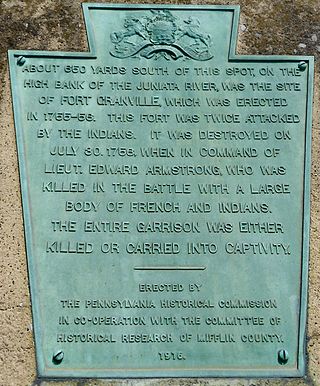
Fort Granville was a militia stockade located in the colonial Province of Pennsylvania. Its site was about a mile from Lewistown, in what is now Granville Township, Mifflin County. Active from 1755 until 1756, the stockade briefly sheltered pioneer settlers in the Juniata River valley during the French and Indian War. The fort was attacked on August 2, 1756, by a mixed force of French troops and Native Americans, mostly Lenape warriors. The fort’s garrison surrendered the strongpoint to these attackers, who celebrated their victory and destroyed the stockade.
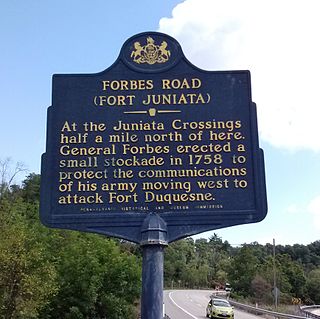
Fort Juniata Crossing, also known as Fort Juniata or simply Juniata Crossing, was a British French and Indian War era fortification located along the Forbes Road, near a strategic ford of the Raystown Branch of the Juniata River about 2.4 miles (3.9 km) west of the current site of Breezewood, Pennsylvania. It was built in 1758 as a fortified supply depot, to support the British Army during the Forbes Expedition. After the campaign, it fell into disrepair and was abandoned in 1763.

Fort Shirley was a military fort located in present-day Shirleysburg, Pennsylvania. It was built in 1755 by George Croghan and later maintained by the Province of Pennsylvania during the French and Indian War. Fort Shirley was part of a defensive line of forts built in Pennsylvania during 1755 and 1756, at the start of hostilities with the French and their allied Native Americans. Although two French and Native American war parties were sent to capture it, Fort Shirley was never attacked. The fort served as the launching site for the Kittanning Expedition in September 1756, after which it was abandoned.
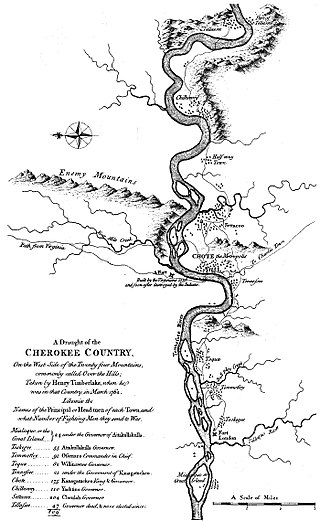
The Battle of Echoee, or Etchoe Pass, was a battle on June 27, 1760 during the French and Indian War, between the British and colonial force under Archibald Montgomerie and a force of Cherokee warriors under Seroweh. It took place near the present-day municipality of Otto, in Macon County, North Carolina.

The siege of Fort Loudoun was an engagement during the Anglo-Cherokee War fought from February 1760 to August 1760 between the warriors of the Cherokee led by Ostenaco and the garrison of Fort Loudoun composed of British and colonial soldiers commanded by Captain Paul Demeré.
William Clapham was an American military officer who participated in the construction of several forts in Pennsylvania during the French and Indian War. He was considered a competent commander in engagements with French troops and Native American warriors, but towards the end of his military career he was unpopular with troops under his command. Following his retirement from the army, he and his family were killed by Lenape warriors on his farm in 1763.

Fort Vause was built in 1753 in Montgomery County, Virginia, by Ephraim Vause. The historic site is near the town of Shawsville, Virginia. It was attacked by French troops and Native American warriors in 1756, and most of the inhabitants were killed or taken prisoner. The fort was rebuilt in 1757 but abandoned by 1759.

Saucunk or Sawcunk was a town established by the Lenape and Shawnees. It was the site of a Catholic mission and was visited by Conrad Weiser, Christian Frederick Post and George Croghan. The Lenape chiefs Tamaqua, Pisquetomen, Captain Jacobs and Shingas all lived there temporarily. Saucunk was abandoned after the Battle of Bushy Run in 1763.

The Black Boys Rebellion, Smith's Rebellion or Allegheny Uprising, was an armed uprising between citizens of the Province of Pennsylvania and the British Army between March 5 and November 18, 1765. The nine-month uprising began when a wagon train loaded with illegal "warlike goods" was discovered at Pawling's Tavern. Alarmed by the train's contents, citizens led by James Smith intercepted and destroyed the goods at a mountain pass near Sideling Hill. The numerous clashes afterwards involved more destruction, firefights, arrests, a kidnapping, legal maneuvers, a court trial, a two-day siege, and one casualty.
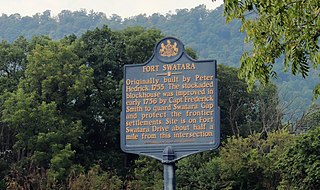
Fort Swatara was a stockaded blockhouse built during the French and Indian War in what is now Lebanon County, Pennsylvania. Initially a farmstead surrounded by a stockade, provincial troops occupied it in January 1756. The fort safeguarded local farms, but a number of settlers were killed by small Native American war parties. The fort was abandoned in May 1758.
Keekyuscung aka Kickyuscung, Kaquehuston, Kikyuskung, Ketiuscund, Kekeuscund, or Ketiushund, was a Delaware (Lenape) chief. In the 1750s he took part in peace negotiations to end Lenape participation in the French and Indian War. In 1754 he briefly engaged in some spying and smuggled some letters into and out of Fort Duquesne for George Washington. He was sympathetic to the British for many years, but in 1763 he and his son Wolf sided with the French after a failed assassination attempt by Colonel Henry Bouquet. He is known for being one of the Native American leaders that attacked Colonel Bouquet's forces at the Battle of Bushy Run, where Keekyuscung was killed.
The Sandy Creek Expedition, also known as the Sandy Expedition or the Big Sandy Expedition, was a 1756 campaign by Virginia Regiment soldiers and Cherokee warriors into modern-day West Virginia against the Shawnee, who were raiding the British colony of Virginia's frontier. The campaign set out in mid-February, 1756, and was immediately slowed by harsh weather and inadequate provisions. With morale failing, the expedition was forced to turn back in mid-March without encountering the enemy.
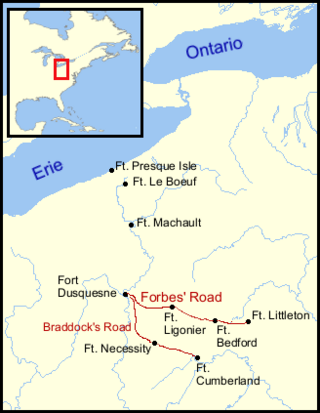
Fort Lyttleton, also known as Fort Littleton, was a militia stockade located in the colonial Province of Pennsylvania. Its site was about a mile from Fort Littleton, Pennsylvania, near Dublin Township, in what is now Fulton County, Pennsylvania. Active from 1755 until 1763, the stockade was initially garrisoned by 75 Pennsylvania troops but at times had as many as 225. It was in use until 1759, then abandoned and reoccupied briefly in 1763 during Pontiac's War.
Fort Allen was a military structure built in Franklin Township, in Carbon County, Pennsylvania in 1756. It was first of several frontier defenses erected by Benjamin Franklin for the Province of Pennsylvania during the French and Indian War. The garrison was rarely more than fifty men, and the fort never saw combat, however it became a center of contact and trade with Native Americans and served as a stopping point for Indians traveling to and from Bethlehem, Easton and Philadelphia. It was abandoned in 1761 near the end of the French and Indian War, and briefly reoccupied during Pontiac's War and again during the American Revolutionary War.
Fort Hunter was a military fort located in present-day Fort Hunter, Pennsylvania. It was initially a stockaded gristmill fortified by Samuel Hunter in 1755 and later enlarged and maintained by the Province of Pennsylvania during the French and Indian War. Fort Hunter was part of a defensive line of forts built in Pennsylvania during 1755 and 1756, at the start of hostilities with the French and their allied Native Americans. It was briefly used during Pontiac's War, then abandoned in 1763.

Fort Northkill was a fort in colonial Pennsylvania, built to protect settlers from attacks by French-allied Native Americans during the French and Indian War. Although the fort was garrisoned by Pennsylvania militia, they were unable to prevent continued attacks on local farmsteads, but the fort did provide some protection for the settlers themselves. The fort appears to have been abandoned in September 1757, but the exact date is unknown.




















